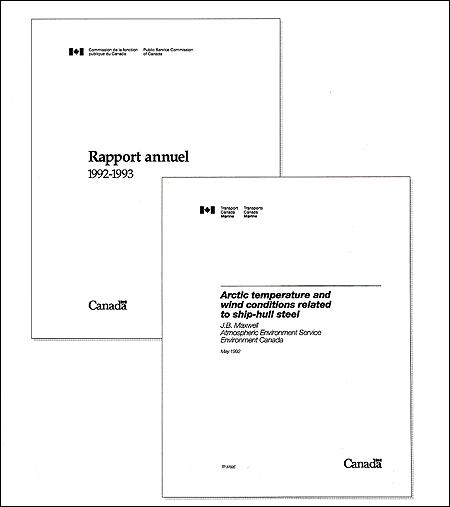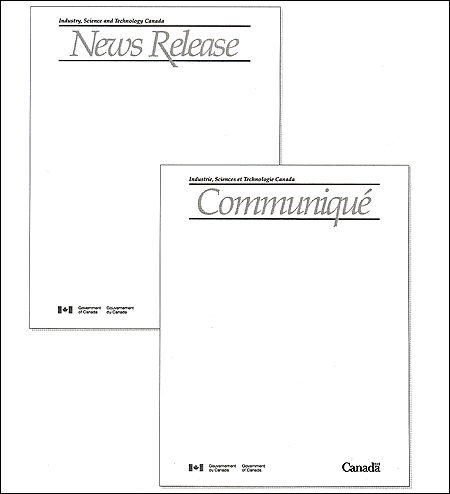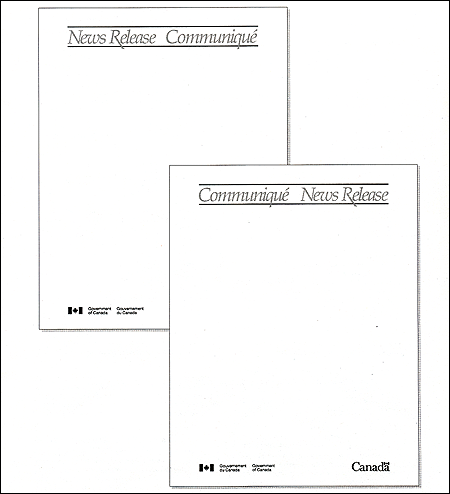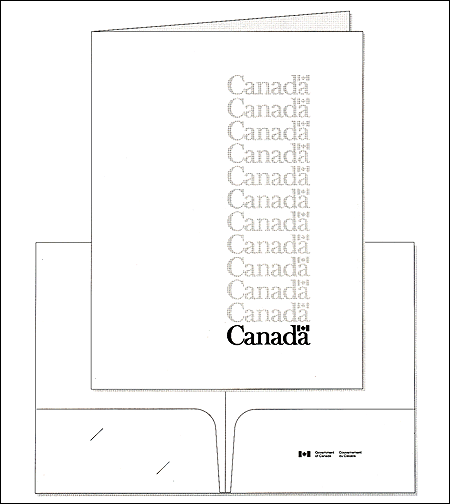Rescinded [2010-12-11] - Planning Information Products: Effective, No-Frills Publishing Practices
This page has been archived on the Web
Information identified as archived is provided for reference, research or recordkeeping purposes. It is not subject to the Government of Canada Web Standards and has not been altered or updated since it was archived. Please contact us to request a format other than those available.
Introduction
These guidelines are a consolidation of Treasury Board directives on "no frills" publishing which were provided to reinforce the February 1992 Budget. These directives call for the streamlining of government publishing and the creation of a uniform "look" for news releases, information kit folders and government report covers. This publication supersedes Treasury Board directives dated July 7, July 30, and September 29, 1992. These guidelines are written in flexible terms taking the approach that there is no single formula to implement "no frills" publishing practices. Basically, these practices encourage sound planning to achieve information products that are economical, well-designed, environmentally sound and that communicate effectively. Each institution will adapt these guidelines to its particular needs.
Enquiries about the implementation of these guidelines may be addressed to: Information Management Practices, Administrative Policy Branch, Treasury Board Secretariat.
Issues and trends. The emergence of an information-based society is affecting government publishing in a major way. The underlying issues are technological change, environmental protection, the shift to a service-oriented culture and the rapid growth of information. These changes are occurring in a climate of public service reform and continued fiscal restraint. Here is an overview of issues and trends:
- the growing shift from print to electronic media;
- the need to minimize environmental impact;
- the demand for easy access and retrieval of information;
- the call for information that is timely, relevant and concise;
- the growing diversity of target publics and changing demographics;
- the need to provide alternative formats (large print, braille and talking books);
- new processes and methods to store, publish and disseminate information;
- the concern for plain language and clear text structure;
- the staggering volume of available information and the effect of information overload and visual noise;
- the call for greater coherence in visual communications.
All these factors influence, in a variety of ways, the methods and practices of disseminating government information. Taken together, they place publishing in an increasingly complex setting.
Application and scope
Application. These guidelines apply to all institutions named in Schedules I and II to the Financial Administration Act and all branches designated as departments for purposes of the Act.
Scope. The guidelines and directives apply to government publications intended for external or internal publics, and to the design of report covers, news releases and information kit folders.
Exceptions. Certain types of publications or product categories have requirements that call for a different approach; the exceptions include:
- a publication related directly to the representation of Canada abroad;
- a priced publication financed through cost-recovery (net voting), e.g. Statistics Canada publications;
information published under a shared-cost program or partnership, when the signing of the agreement predates the "no frills" guidelines;
- information that could not be communicated effectively through one-colour printing (e.g. functional use of colour in geographic mapping or when presenting health and safety information).
Even though a publication falls under one of the exceptions, the decision to use a more expensive presentation should be weighed carefully in light of the intent of the "no frills" approach.
Objectives
The "no frills" guidelines have the following objectives:
- to streamline publishing activities by eliminating non-essential publications, and by retaining all "duty to inform" and other essential publications;
- to encourage sound planning with a focus on user needs and cost-effectiveness;
- to promote economical methods of production and distribution, and to minimize environmental impact; and
- to establish a uniform "look" by means of standard formats for news releases, information kit covers and government report covers.
These objectives reinforce the directions taken in the Communications Policy. The requirement to publish in both official languages remains unaltered and cost-reduction initiatives must not affect the ability of institutions to meet their obligation to serve the public in either English or French.
Publishing and dissemination plan
Institutions may find it helpful to use internal review committees to prepare a publishing plan and to raise questions such as:
- Is it a statutory requirement, is there a duty to inform?
- Does the publication have to be in both official languages?
- Is it based on an analysis of information needs identified by target groups or by the general public?
- Will the publication ensure effective dissemination of the message both in terms of reaching the target public and cost/benefit?
- Should existing publications be reviewed for the purpose of consolidation or restructuring?
- Will the information be disseminated in different versions or media (print, electronic, large print, audio cassette)?
- Are evaluation plans built into the publishing project to permit critical assessment?
Greater efficiency and cost savings may be achieved with the help of a dissemination plan. The following questions might apply:
- Could printing and distribution costs be reduced if the product were targeted better?
- Would methods such as "on-demand" or "distributed" printing help to achieve savings?
- Are distribution lists maintained, updated and coordinated across the organization?
- Do the mailing lists reflect the official languages in which the products should be disseminated?
- Should current methods be evaluated in view of shifts to electronic distribution and user needs?
- Does the dissemination plan ensure that copies of all free and priced publications are sent to the Depository Services Program, the Library of Parliament, the National Library and the institutions own library?
- Are mechanisms in place that provide feedback on the level of demand and client satisfaction of a product?
Access and retrieval
The growing demand for easy access and retrieval of government information calls for good references such as directories, indexes and catalogues. All these sources help in disseminating information and delivering government services. Here are some points that will assist the public to find and select information:
- The titles of publications should be formulated with the user in mind; this means they should be sufficiently descriptive but at the same time concise (a subtitle may help to this end).
- The usefulness of reference documents is improved when content outlines or abstracts are included. References should also include information on the availability of alternative formats or adaptive equipment.
- The retrieval of information depends on the consistent use of identifiers such as catalogue number, ISBN, ISSN, CIP data and bar codes.
The rapidly growing volume of information suggests that accessibility should be part of the planning process. This means greater concern for a products "global accessibility" (e.g. catalogues, directories, content lists, indexes) and "local accessibility" (e.g. headings, structure, layout).
Product planning
The initial step is to define the requirements by addressing all aspects from design concept to production to dissemination and, of course, user needs. Principles for the planning of printed and electronic products are set out below; for a more comprehensive approach refer to "Best practices" at the end of this document.
Printed products. A products format and size, and the use of paper and ink colours, have a direct influence on cost and environmental impact. Many of these factors interact, and estimates of potential savings may be determined by comparing the unit costs associated with different methods and processes. To ensure that a design is consistent with the "no frills" approach it will be important to:
- Use a format compatible with common manufacturing and distribution methods, and ensure it is based on standard paper sizes, printing press sizes and container or envelope sizes.
- Use the format best suited to disseminate information in both official languages (separate versions or a bilingual format) by assessing factors such as accessibility, availability, dissemination, printing and distribution costs, and environmental impact.
- Use one-colour printing wherever possible, and limit multi-colour printing to products where it is a functional requirement (e.g. when presenting information such as geographic maps, charts, or safety instructions).
- Select the appropriate paper on the basis of user needs, cost and environmental impact; such factors include: product life cycle; archival value and use of permanent paper; surface finish; grammage; opacity; handling and distribution; and of course, recycling.
- Select cover stock on the basis of functional needs (handling, method of binding, product life cycle); consider using the same paper (self-cover) for both contents and cover, where feasible.
The inter-relationship between a products manufacturing cost and the environmental impact are apparent. Applying the "no frills" approach means concern for the use of materials and processes, energy consumption, product life and recycling. It means greater care when specifying materials or processes such as paper, ink coverage, coatings, binding, packaging and distribution. This approach to product planning is becoming known as "responsible" design.
Electronic products. Different user needs, the variety of available products, and the interactive nature of electronic publishing call for a comprehensive planning approach. This involves many factors including: user access; reproduction (text, graphics, sound); storage capacity; text retrieval software; user manual; applicable standards; and links with other information sources.
It is clear that conventional publishing practices need to be adapted to exploit fully the capabilities of electronic information transfer. This applies particularly to the way information is organized, how texts are structured and how graphics are presented.
Design of report covers
The cover designs of annual reports, technical and scientific reports, and of any publications internal to government, are to be fully consistent with the "no frills" approach. This means utilizing cover designs based on one-colour printing, a simple typographic layout, and no illustrations. These design criteria apply to all formats, printed and electronic. The objective is to present federal reports and internal publications in a coherent, clear and simple manner.
The result is a functional design that features the title and all essential information such as authorship, corporate identity, catalogue number, date. The nature and scope of a particular report, or a series of reports, may be reflected by the typographic design.
Standard news releases and information kit folders
Requirements. Institutions (see note) are required to use the standard news release forms for all federal government announcements. The standard information kit folders are to be used when providing background information to the media or at public events.
Note: The use of standard news releases and kit folders does not apply to institutions that use the Coat of Arms for purposes of identification, nor does it apply to institutions that have been exempted from the Federal Identity Program.
Implementation. The Treasury Board directive of July 7, 1992, stated that implementation takes effect as soon as current stocks of departmental news release forms or information kit folders are depleted.
Means of identifying institutions. In view of the universal nature of the "Government of Canada" signature, the institution making the announcement may need to be identified. Such identification may consist of the title but not the corporate signature of the institution (i.e. only the "Government of Canada" signature may appear on these forms). The institutions title may be pre-printed in the top band of the form (a space provided for this purpose) or, alternatively, it may appear in the heading of the announcement.
Electronic dissemination. Although a printed format was the basis for standardizing news releases, print distribution is not the sole or preferred method. In fact, initiatives to disseminate announcements in a more cost-effective manner (e.g. online or by facsimile) are encouraged. When using such a method, the electronic version should reflect the design of the printed format to the extent possible.
Use of kit folders. In addition to its primary purpose to distribute background information to the media, the folder is also for general use at conferences, exhibitions or similar events. To identify an institution, there is a provision to insert a card (calling card format) on the left inside pocket of the folder.
Procurement. Institutions have the option to arrange for their own printing, to use the Automated Printing Network of the Canada Communication Group, or to purchase the items from SIS (stocked items in supply). The artwork, electronic files and printing specifications are available, upon request, from the Treasury Board Secretariat.
Enquiries concerning the Automated Printing Network should be directed to the Product Development Centre, Canada Communication Group, Tel. (613) 941-5410.
When purchasing the items from SIS, the order should be addressed to the
Capital Region Supply Centre, Supply and Services Canada, 1010 Somerset Street
West, Ottawa, Ontario K1A 0T4,
Tel. (613) 957-3468.
The standard items exist in several versions (unilingual, bilingual) to meet different needs. When ordering, the following designators should be used:
News release
GC 194 (92/06), 7540-21-886-3757
Communiqué
GC 195 (92/06), 7540-21-886-3758
News release/Communiqué
GC 193 (92/06), 7540-21-886-3756
Communiqué/News release
GC 197 (92/06), 7540-21-886-4897
Information kit folder (English/French)
GC 224 (92/06), 7540-21-909-1811
Information kit folder (French/English)
GC 225 (92/06) 7540-21-909-1812
Illustrations of Report Covers, News Releases and Kit folders




Best practices: managing quality and design
Introduction
Many publishing practices and roles have been transformed through technology and the demands of an information-based society. These shifts point to new approaches in managing the quality and design of publications. Described here are best practices when developing printed or electronic products.
The practices are based on the premise that the quality of the final product is integral to the planning process, and that design is both a process and an end product. These practices focus on a design review to help bring various interests together, to take the needs of users into account, and to ensure that communications objectives and functional requirements are met.
What is a design review?
A design review is a process of quality management which consists of three stages: input / output / verification. More specifically, a review is an analysis to evaluate requirements and the capability of the design to meet these requirements, to identify problems and to propose solutions. The capability of the design includes aspects such as utility, performance, target public, user needs, access and retrieval, interface, life cycle cost, environmental factors, marketing, reproduction, storage and dissemination.
The review process is a practical tool when developing a product and helps to ensure that design is effectively managed and utilized. Other advantages are better coordination, clarity of procedure, improved budget control and time scheduling. While reviews will raise the awareness of the design process, it is clear that a review by itself does not ensure proper design.
Design reviews are used in many fields and industries. The concept was adopted by ISO (International Organization for Standardization), and has become part of a comprehensive set of world-wide standards on quality management known as the ISO 9000 series.
Input / Output / Verification
Input. Typically, an input consists of performance criteria for the presentation of information and the configuration of the product. Inputs will vary according to the media (print or electronic) and the scope and complexity. In some cases it may be no more than a checklist.
Besides the functional requirements, an input may also state the basic design approach. There often is a need to look at design issues in a broad, strategic context to ensure coherence of visual communications.
A document, known as the design brief, is used to capture pertinent inputs with respect to performance and all functional, environmental and policy requirements. The briefs purpose is to establish a unified design approach and clear terms of reference. The brief is used also to resolve conflicting requirements and to identify those design aspects, materials, processes or costs that require further analysis. Depending on the nature of the project, this may call for the development of prototypes and testing to establish the appropriate course of action.
In summary, a brief is an important first step in the design process and serves as the definitive, up-to-date reference as a project progresses to completion. During this process, the brief is revised as issues are being resolved.
Output. The requirements stated in the brief are translated by the designer into outputs such as concept outlines, design systems, diagrams, layouts, artwork, films, electronic files, mock-ups, prototypes, and specifications for materials and processes. At the appropriate stage, the design output should provide information on pricing, procurement, production, inspection, testing and dissemination.
Verification. The verification assesses the output on the basis of input and typically raises the following questions:
- Does the design satisfy the requirements that were defined; will it be cost-effective to reproduce, to store and to disseminate?
- Does the product meet the functional requirements for accessibility, retrieval, legibility and readability?
- Are the materials and processes suited for the purpose, and do they help minimize environmental impact?
- Does the product meet the requirements of federal information policies (e.g. communications, official languages, fair communications practices, privacy, copyright, corporate identity)?
- Have the needs for alternative formats been taken into account (large print, audio cassettes, braille)?
- Were national or international standards considered and applied where appropriate?
- Does the product conform to corporate practices, government regulations and international usage?
- How does the design compare with similar products and how will it be perceived and accepted by users?
In essence, a review process can ensure that the design solutions are sound and that they can be translated into quality information products.
Suggested readings
Dumas, Angela and Mintzberg, Henry, Managing Design Designing Management, Design Management Journal, Vol. 1, No.1, Fall 1989, pp. 37-43, ISSN 1045-7194, Boston, MA.
Government of Canada, Communications: A Guide to Good Communications Management, Cat. No. BT32-36/3-1992, ISBN 0-662-58909-2, Treasury Board Secretariat and Office of the Comptroller General, March 1992.
Information Design Journal, ISSN 0142-5471,
PO Box 185, Milton Keynes MK7 6BL
ISO 9000 Compendium, International Standards for Quality Management, International Organization for StandardiFzation, ISBN 92-67-10172-2, 1992.
Whitney, Patrick et al, Design in the Information Environment: how computing is changing the problems, processes and theories of design, Random House of Canada Limited, Toronto, 1985, ISBN 0-8093-1251-4, (175 pp.).